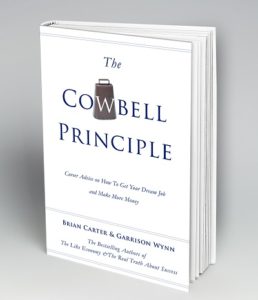10 Rules For Mind-Blowing Content Brainstorming Sessions
By Lynette Young October 29, 2014
This post is an excerpt from the book The Cowbell Principle: Career Advice On How To Get Your Dream Job And Make More Money, by Garrison Wynn and Brian Carter.
Brainstorming new ideas is something that content creators, especially for business, strive to keep fresh. Whether you’re writing new blog posts, email broadcasts or content upgrades, the problem is that work and life get in the way and generating new ideas can seem forced if not given the proper time and framework.
So how do you brainstorm new ideas?
According to Garrison Wynn and Brian Carter, co-authors of the book “The Cowbell Principle: Career Advice On How To Get Your Dream Job And Make More Money,” there are ten rules you should adhere to in order to get those creative ideas flowing and stay on track with content brainstorming sessions.
——
Everyone has at least one cowbell — it’s your unique, profitable talent that people pay you for or your company’s unique offering. When you discover it and give those people a ton of it, you gain success and happiness for both yourself and others. It’s a win-win.
A cowbell is simultaneously something you love doing and something other people really want as well (although, as we’ll see, you still will have detractors and critics). A cowbell creates joy for you and other people. It makes them yell for more. They can’t get enough.
Some creativity required, batteries not included
Creativity is a big deal these days, because content marketing is the hottest digital marketing trend. More and more content is posted every day, but we each only have so much time for consuming content each day. We’re picky about what we read and we have more choices. That supply and demand equation means your free content has to be even more valuable!
As a marketer you want your content to stand out so you need to get creative – and that means you need an effective brainstorming process. Brainstorming can give you fresh and exciting ideas for many content types, including blog posts, ebooks, infographics, emails and headlines. Here are 10 tips to help you have the most productive brainstorming session:
10 rules for a mind-blowing brainstorming session
1. No negativity. Ironically, I have to be negative about negativity here. No analysis or criticism or comparing or editing of other people’s ideas. Be positive about every contribution.
2. All ideas are valid at this stage. Think about what’s good or bad later.
3. Everyone contributes. Non-contributors should leave, because otherwise they make the contributors self-conscious and can lower the energy level.
4. No computers or tablets or cell phones. Phones need to be completely silent. Buzzing phones are not acceptable. Have someone assigned to writing the ideas on a whiteboard. This person has no extra power in the brainstorming session and must contribute ideas too. You can switch up who’s writing them down every 10 minutes or so if you want. Another approach is to give everybody post-its and as they come up with ideas they just post their own post-its on one communal wall.
5. Every idea is welcome, even dumb or crazy ones. Especially dumb and crazy ones! Purposely trying to think of stupid ideas can break through your internal judgment, which otherwise holds you back.
6. Build on other people’s ideas. You may combine ideas during the brainstorm, or save idea combinations for a second brainstorming session. At times, that combining approach can be too analytical and may slow you down.
7. Come up with as many ideas as you can. Strive for quantity not quality. It’s a good idea to have individuals brainstorm by themselves both before and after the group brainstorm session.
8. Take turns talking. Listen when you’re not talking.
9. Forget the past and think about the future instead. Figure out if ideas fit with your corporate values and traditions later, not while you’re brainstorming.
10. Resist tangents like storytelling and joking. Too much talking by any one person can drain the group’s energy.
What do these rules mean?
When you’re writing or brainstorming, you must have the attitude that every idea is good. Everyone who’s going to brainstorm has to agree to support everybody’s ideas and vocalize all of theirs. Make it a judgement-free zone like Planet Fitness. After all, you’re not making a commitment to the ideas yet – you’re just sharing them.
Similarly, when you write blog posts or articles, you should not be editing. Do creation and editing at separate times. Just get everything typed out. Fix problems and polish it up later.
A brainstorming session is not the time to try to look good. If there’s someone in the room everyone’s trying to impress or who they’re afraid to anger or look bad in front of, even if (especially if) that’s the boss, you need to get that person out of the room, or that person needs to affirm all the brainstorming rules we’re talking about here.
A quiet person of great authority in a brainstorming room is intimidating. If you aren’t going to contribute ideas, don’t go into the brainstorming room.
——
Brainstorming new content is a big deal and you can get really creative ideas out of it, but only if you follow these 10 rules to maximize the value of content brainstorming sessions.
Looking to cut down time spent on the brainstorming process for your emails? Try using these email templates with pre-written content for your email marketing campaign.
 87% off ends soon!
87% off ends soon! 
